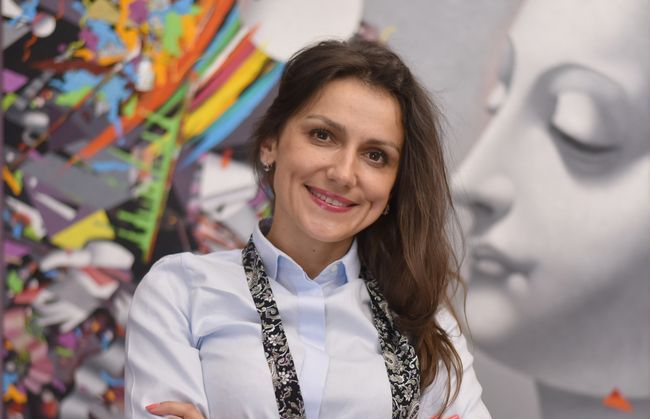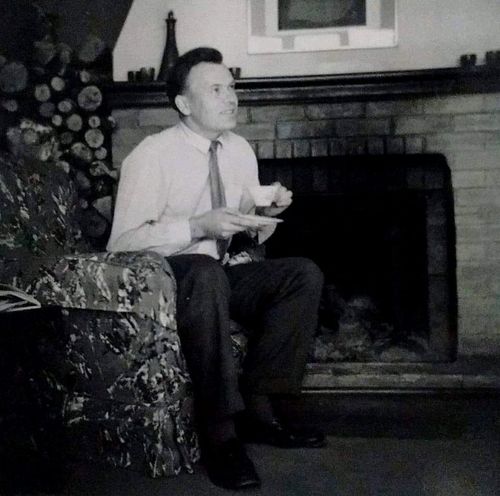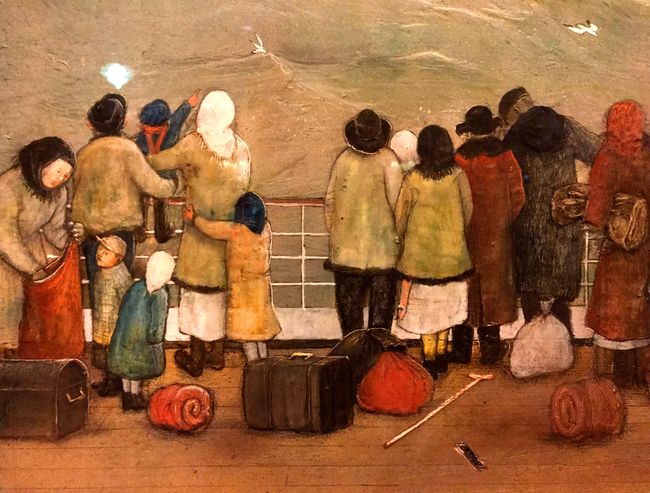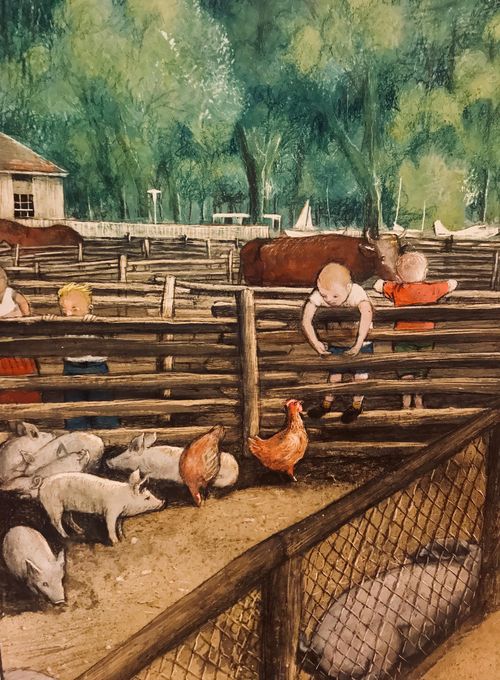The Ukrainian-Canadian Brueghel
Art critic Khrystyna BEREHOVSKA says William Kurelek lived each day in a different world
William Kurelek’s first and last name would have been Vasyl Kurylyk in Ukraine, the land of his forefathers, but he was born in Canada, where he was destined to become a distinguished Ukrainian-Canadian artist. His works are displayed in Canadian and US public art galleries and held in private collections, including those of Queen Elizabeth II and former Canadian prime ministers.
He died at the age of 50, having constantly struggled with his mental illness, leaving behind 10,000 paintings and prints. There are 36 books written by him and about him in Canada, including 400,000 copies of his A Prairie Boy’s Winter (1973) and A Prairie Boy’s Summer (1975), translated into 18 languages. He treasured his ethnic Ukrainian identity, although few people in Ukraine, apart from art critics, know about him. Fortunately, the first publication dedicated to his The Passion of Christ According to St. Matthew series (1975) appeared in print recently. Kurelek was the first artist to illustrate all of St. Matthew’s Gospel: 160 works described by critics as masterpieces of religious art. In his last will and testament he wrote that he wanted The Passion of Christ to become known in Ukraine.
Khrystyna BEREHOVSKA, the author of the art catalogue, is studying the Kurelek Phenomenon in world art, the topic of her doctorate at the Lviv National Academy of Art. She is determined to compile at least part of his creative legacy and promote it in Ukraine.
Ms. Berehovska kindly agreed to an interview. We spoke about Kurelek’s eventful life and decided to focus on the educational aspect of his legacy, as well as on what related to his Ukrainian parentage, so the following is her story.
PEDAGOGICAL LOGIC BASED ON ART
William Kurelek was born near Whitford, Alberta, in 1927. He spent his youth in Manitoba. His father came from Bukovyna in western Ukraine. His mother’s family was among the first Ukrainian immigrants in Canada. His relationship with his father left much to be desired, as his father refused to understand his elder son’s creative inclinations. The artist wrote later that his father treated him ruthlessly and would chase him out of the house in winter, leaving him without a coat and hat when the temperature was down to 30oC; that he would often tell him that his younger brother was much smarter. This inevitably led to various complexes and phobias. Kurelek later said he was a fatherless son, even though he had a father. This would determine his main creative trend: the contrast between hatred and love, God and atheism, complete with angels and monsters. Parents and children were a frequent theme of his works. Pedagogical logic is based on his creative legacy and it is quite popular in Canada.
Children often figure in his works. He had a difficult childhood and that was his way of making up for it, by portraying children, focusing on their inner world rather than their image. He was a loner from childhood and eventually became an introvert. His peers considered him peculiar, primarily because of the language he used. He spoke only Ukrainian until seven years of age. During his childhood, the future artist was both amused and depressed by his environment. For him, that environment was packed with contrasts. After he made his name as an artist, he decided to relive that experience in his works, depicting children of that time – so that his posterity would know as much about the way all those immigrant kids grew up in the Canadian prairies, what they looked like, how they spoke, as they would about the Inuits. He vividly displayed that Irish kids were different from their French peers, and that all this was part of Canadian multiculturalism.

WILLIAM KURELEK, OCTOBER 1961 (PHOTO COURTESY OF THE KURELEKS’ PRIVATE ARCHIVES)
He was probably the only Canadian artist to illustrate this multiculturalism and his pioneer series won him the reputation of Manitoba-born Brueghel, Canadian Bosch, or Prairie van Gogh. He loved the way Breughel portrayed many people in one place and there are many children captured in motion in his pictures. They aren’t static, they are dynamic, full of life, and they look intelligent – something the artist always emphasized.
KURELEK, AN EXAMPLE
According to Ms. Oksana Wynnyckyj-Yusypovych, Canadian Consul in Lviv, William Kurelek was an example her generation wanted to emulate, and that many children are of the same opinion. She specified that she was referring to Ukrainian-Canadian children who attended Ukrainian language schools; William Kurelek painted pictures and added captions explaining what a given picture was all about. He would paint children in the Canadian prairies and explain that they had to go to school and do household chores, including collecting hay, herding cows, and so on. Most children, born in today’s big cities with their high-rise condominiums and skyscrapers, don’t have the slightest idea about how to milk a cow or the difference between a goose and a hen, but they can see it in Kurelek’s pictures. He canonized the immigrant’s daily manual labor and his rural way of life. Mother and child were, of course, uppermost on his mind. He painted series of pictures, not just portraits, like the ones with a mother and daughter cooking jam, with a woman using her ax, chopping firewood, and her daughter collecting the logs, or with her teaching her daughter to make the sign of the cross in front of an icon. He placed special emphasis on team work and education. There is a picture in which a child is about to get into a basin with hot water and his mother is pointing a forbidding finger. He painted a lot of such pictures and they can be used as teaching aids for children, showing the way they should behave at home.
GUIDED BY GOD
Almost each picture he created was a quest. He would come up with five outwardly identical pictures for children, but warn that there were 10 differences between them that had to be found. Such pictures currently sell at 50 to 300 Canadian dollars. He believed that every child should be encouraged to start learning high culture from the earliest possible age. In fact, this education system, based on intellectual and professional skills, is still being practiced in Canada.
William Kurelek flew to Brussels to see how Breughel depicted children. He also visited Amsterdam to see Vincent van Gogh’s works. And then he made a trip to India to study the contrast between the rich and the poor. He always took a special interest in the poor, even after he became a man of considerable means. While in India, he donated to various orphans’ funds. He would visit again to make sure his money had made their life easier.
His art is still serving to educate children, although he never cared about his own children’s education, but he often portrayed them in his works. His 10-year-old daughter is depicted as an adult angel standing with other angels by the Holy Sepulcher in his picture The Passion of Christ. For him, it was more than a painting. He adored children and saw them as cherubs and seraphs. Interestingly, he never referred to himself as a typical artist. He said he was a craftsman. Why? Because, he said, he had only the tools to make what God wanted him to make. He was, actually, a true believer and his Faith was probably the most important part of his life.
DIFFICULTIES OVERCOME THROUGH ART
With all his creative accomplishments, a story about William Kurelek would be incomplete without mentioning his major affliction, I mean his mental disorder [although he died of cancer in the end – Ed.]. School bullying caused him to become an introvert. This and frequent family conflicts resulted in long periods of deep depression with which he would struggle for the rest of his life (few if any prefer to comment on this part of his biography). He started drawing and painting at an early age. Later, he received professional college-level training in Canada and Mexico… He coped with his physical/mental problems by painting – his doctors at the Maudsley Psychiatric Hospital in London thought it was the best treatment and he believed them. He was provided with paints, brushes, easels, the works. The result was spectacularly positive. Bethlem Royal Hospital has a museum where Kurelek’s pictures and sketches occupy a place of honor.

THE UKRAINIAN PIONEERS (1972), PART OF THE MURALS; MIXED MEDIA (152.5x729 CM; 152.5x121.5 CM), NATIONAL GALLERY OF CANADA (PHOTO TAKEN BY KHRYSTYNA BEREHOVSKA ON THE PREMISES OF THE GOVERNOR-GENERAL OF CANADA IN OTTAWA)
Mental disorder had a tangible impact on his creativity. William Kurelek sustained a total of 14 electroshock therapies. I spoke to a psychiatrist and was told that the patient would never be his old self after this therapy. William Kurelek would meet the next day in a different world (in his mind). Interestingly, all photos show him as a cheerful, smiling individual. His relatives and other people who knew him insist that he was always sad. This complicated my task of putting the pieces of the puzzle of his personality in place. In fact, all who knew him told me different things about him. I had the impression that I was dealing with a split personality.
TRUE TO UKRAINIAN DESCENT
As an adult, William Kurelek would always emphasize his Ukrainian parentage. Among his works is the mural The Ukrainian Pioneer, currently on display on the premises of the Governor-General of Canada. Ukrainian themes are traditionally present in his works, including the images of Taras Shevchenko, Ivan Franko, and Lesia Ukrainka that are found in his big multifunctional pictures. William Kurelek was always aware of his ethnic Ukrainian origin, although he couldn’t speak fluent Ukrainian and didn’t know Ukrainian grammar. His heart was with Ukraine. He was bullied in school because he spoke a language no one understood. He spoke Ukrainian to those who spoke English, but the bullying had its effect and he would find it hard to speak Ukrainian later. In fact, he hardly ever tried. But then, in 1970, he first flew to Soviet Ukraine to visit his father’s home village of Borivtsi in Chernivtsi oblast. His second cousin told me that he remained silent during the first day. The following day he went to the kitchen garden behind the house and started talking to himself in Ukrainian. Imagine the reaction of his relatives who happened to witness the scene. They all knew that he couldn’t speak Ukrainian. Another interesting detail. When I visited Borivtsi with his sister Nancy, she found herself lapsing into accented, stilted Ukrainian. She still remembered words and phrases she’d learned from her mother.

LATE SUMMER, CENTRE ISLAND (1972), KHRYSTYNA BEREHOVSKA’S PHOTO OF PART OF THE PICTURE IN A PRIVATE COLLECTION, MIXED MEDIA (120x60 CM)
William Kurelek always kept in touch with his relatives in faraway Ukraine. He would visit a local Ukrainian school and ask a teacher to translate into Ukrainian and write what he wanted to tell them. He never forgot about Ukraine, looking for the English versions of Ukrainian books, especially Taras Shevchenko and Ivan Franko. There were few sources at the time.
WILLIAM KURELEK MUST BE KNOWN IN UKRAINE
He visited the land of his forefathers twice, leaving several of his works whose value remains to be determined by experts. Canada is jealously guarding his creative legacy, stressing that he was a Canadian artist. The sad fact remains that few in Ukraine know about this gifted personality. The good news is that I’m not the only one who is dealing with his Ukrainian origin. There are Christine Curkowskyj in Canada and Roman Yatsiv. It is very important that William Kurelek’s legacy be promoted in Ukraine. He is an artist of international acclaim and deserves every credit in the land of his forefathers. In 1961, after his first exhibit, he said something he would write in Someone With Me: An Autobiography (1980), that in Canada his creativity was first discovered by Jewish women and then by the entire ethnic Jewish community; that it would be later appreciated by the ethnic French, Anglo-Saxon, and, lastly, by the ethnic Ukrainian community.
How to promote William Kurelek in Ukraine? Organizing his art exhibits across Ukraine seems the best way – and my cherished dream is to see his Passion of Christ on display. Of course, I realize that this is easier said than done, that it is wishful thinking, most likely. New Ukrainian history textbooks are being written and I’m sure that each should have a chapter dedicated to the Ukrainian Diaspora boasting names like Alexander Archipenko, Jacques Hnizdovsky, and William Kurelek.
Newspaper output №:
№48, (2018)Section
Culture





